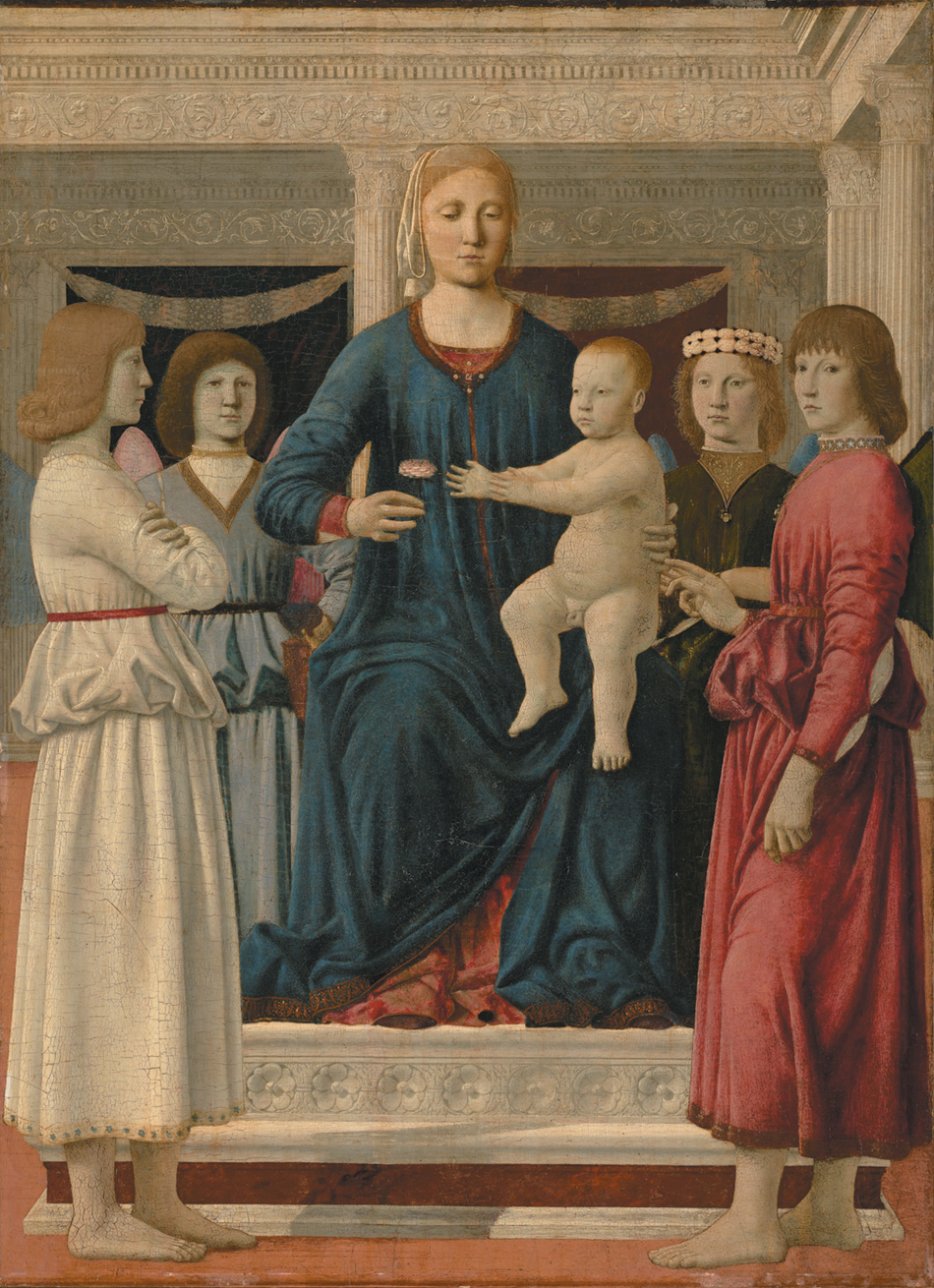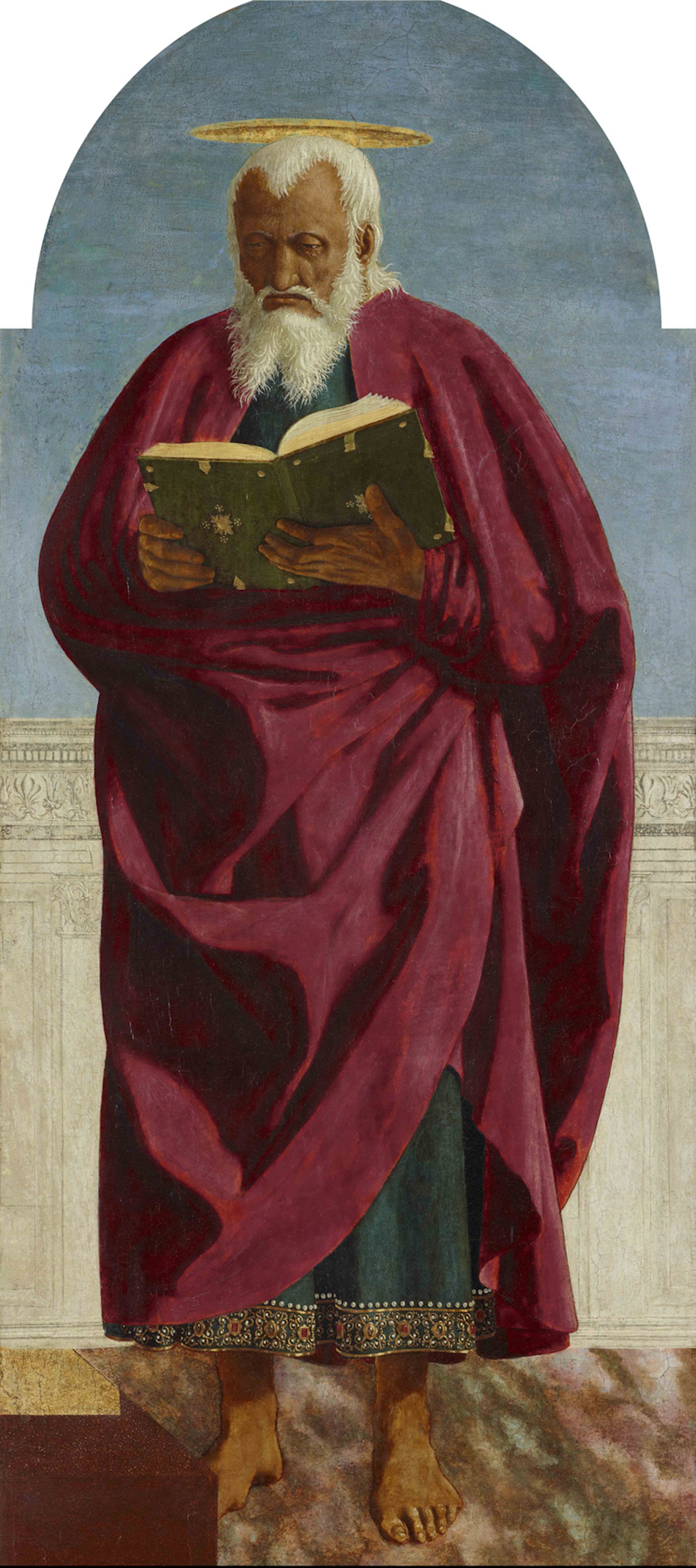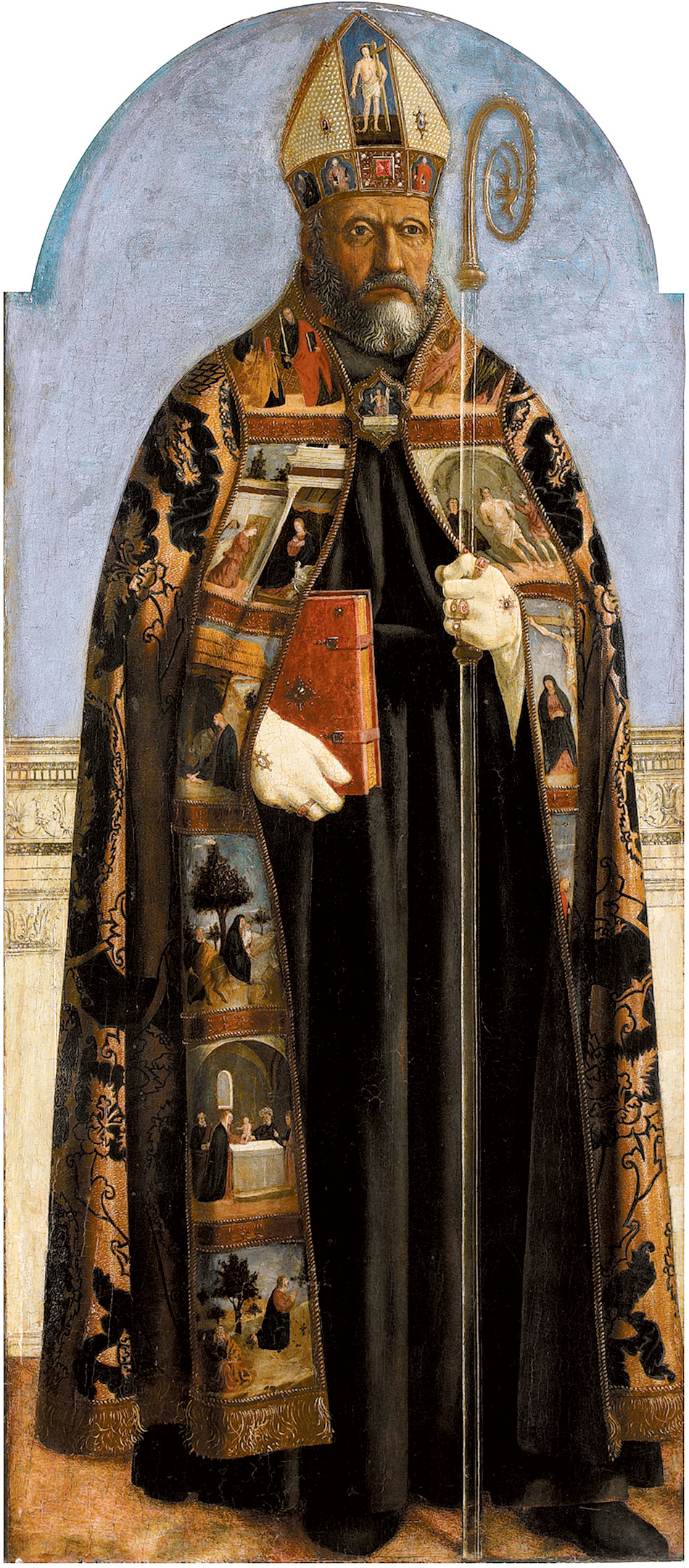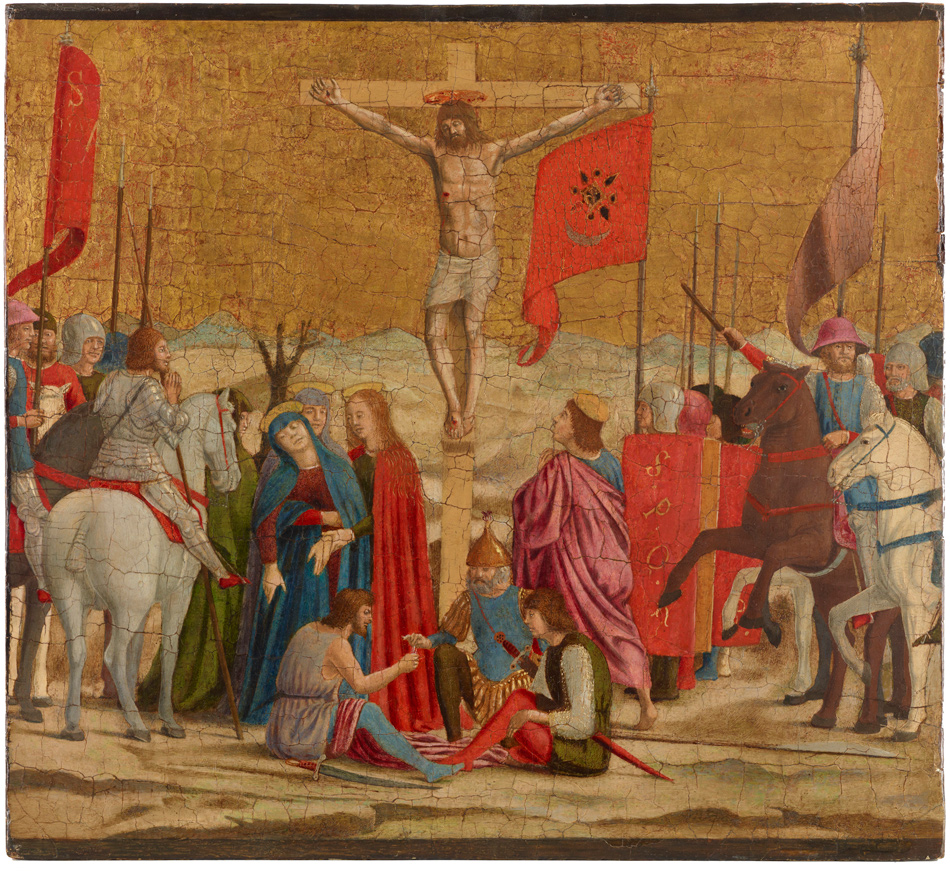Why is Piero della Francesca so different from other quattrocento artists? The longer one contemplates his work, the more imperative that question becomes. It haunts the viewer of the current exhibition at the Frick Collection, where more paintings by Piero are brought together in one room than anywhere except in Arezzo. The seven paintings in this exhibition, four of which belong to the Frick, are not the very greatest of Piero’s works, but they exemplify much of his achievement. Four of them are masterpieces, and this exceptional opportunity to see so many panel paintings of Piero at once is instructive.
Various attempts have been made to explain Piero’s unique qualities since his “rediscovery” in the late nineteenth century, many of them insightful. Early on, John Addington Symonds claimed that “by dignity of portraiture, by loftiness of style, and by a certain poetical solemnity of imagination, he raised himself above the level of the mass of his contemporaries.”1 Of course, Piero was also indebted to some of those contemporaries, and his relationship to Florentines such as Domenico Veneziano and Uccello, as well as to Flemish artists, has long been acknowledged. Yet in most respects the influence of others upon his work seems to be fairly minimal, and one might argue that he had a greater debt to the architect and humanist Leon Battista Alberti than to any of his painting predecessors. What is it, then, that makes him so distinct from his contemporaries?
Piero’s innovative use of oil paint and his perfection of perspective are two qualities that have been often discussed, as have his use of color to express form and his ability to evoke space. His phenomenal mastery of light and his breathtaking depiction of it have also been repeatedly noted.2 But Piero’s singular importance in the history of landscape painting has, so far as I am aware, rarely been adequately appreciated; yet his landscapes are some of the most accomplished, evocative, and innovative in Italian art before Giovanni Bellini.
Then there is the unemotional, inexpressive quality of his paintings, which so sharply distinguishes him from other painters. Bernard Berenson famously wrote about the “inarticulate” in Piero, claiming that he “seems to have been opposed to the manifestation of feeling, and ready to go to any length to avoid it.”3 “The quiet chant of the air and the immense planes are like a choir against which Piero’s dramatic personae remain silent,” says the Polish poet Zbigniew Herbert.4 There is also a serene immobility that characterizes his personnages, which is unlike the work of any other painter of his time. These qualities, inexpressivity and immobility, have been beautifully articulated by Herbert, my favorite writer on Piero:
The principle of tranquility does not lie merely in architectural balance. It is a principle of inner order. Piero understood that excess movement and expression both destroy the visual painted space and compress the painting’s time to a momentary scene, a flash of existence. His stoic heroes are constrained and impassive. The stilled leaves, the hue of the first earthly dawn, the unstruck hour, give the things Piero created an ontological indestructibility.5
But what, in the end, is most idiosyncratic about Piero is the essential nature of his mind, which was molded both by artistic and by mathematical, geometric perceptions—a perfect union of art and science. When Piero looked at the world, he ineluctably perceived its geometric forms and mathematical perspectives, and it is this uncommon mental capacity that caused Roger Fry and others to see him as a precursor to the formalism of Cézanne and Seurat. This quality was not, however, abstractly expressed in cubes and spheres, but rather was realized in his naturalistic delineation of the world inherited by Adam’s descendants.
In his biographical account of Piero della Francesca, Vasari takes special note of one of his altarpieces. It is the first known reference to the work to which six of the seven pictures in the exhibition of Piero at the Frick Collection belong: “In the convent of the monks of Saint Augustine (in Borgo San Sepolcro), he painted the altarpiece for the high altar, which was much praised.”6 The commission given Piero for this work by the donor, a resident of Borgo San Sepolcro with a characteristic name of sequential descent, Angelo di Giovanni di Simone d’Angelo,7 was signed on October 4, 1454, and stipulated that the altarpiece should be a work comprised of several panels and should be completed in eight years; it also explained that the altarpiece had been commissioned to fulfill the wishes of Angelo’s late brother Simone and his wife Giovanna.8
But Piero, a notoriously slow painter, had other obligations at the same time, including the completion of his celebrated frescoes in the church of San Francesco in Arezzo and work in Rome for the pope, and the altarpiece does not appear to have been finished until around 1470. The chronology of Piero’s works is uncertain and contentiously disputed, but most scholars date the Sant’Agostino polyptych to the decade of 1460–1470.
Advertisement
A century later, in 1555, the church of the Augustinians passed to the nuns of Santa Chiara, and they remodeled and reconsecrated it, replacing some of the works of art with others more appropriate to their order. For many years, art historians assumed that Piero’s altarpiece had been broken up at that time and dispersed. But in 1990 an archival scholar in Sansepolcro, Franco Polcri (who was subsequently elected mayor of Sansepolcro in 2006), discovered a document dated 1825 in which an unknown person lists all the major paintings in the city. One of the entries for the church of Santa Chiara reads: “Sotto l’organo vi è la Vergine con un bambino in braccia, S. Agostino e S. Niccola—Pittura di Piero della Francesca” (“Beneath the organ there is the Virgin with a child in her arms, St. Augustine and St. Nicholas—Painting by Piero della Francesca”).
Not only does this discovery reveal that at least some of the panels remained in the church until the early nineteenth century, but it finally resolves the question of what was depicted on the missing central panel: a Madonna and Child, as many scholars had surmised, rather than a Coronation of the Virgin, as some others had conjectured. (Surprisingly, this important discovery appears to be unknown to the authors of the Frick catalog, who continue to say, “The missing central panel depicted either the Virgin and Child Enthroned or the Coronation of the Virgin.” Polcri’s pamphlet is not listed in the catalog’s bibliography with his other work.9)
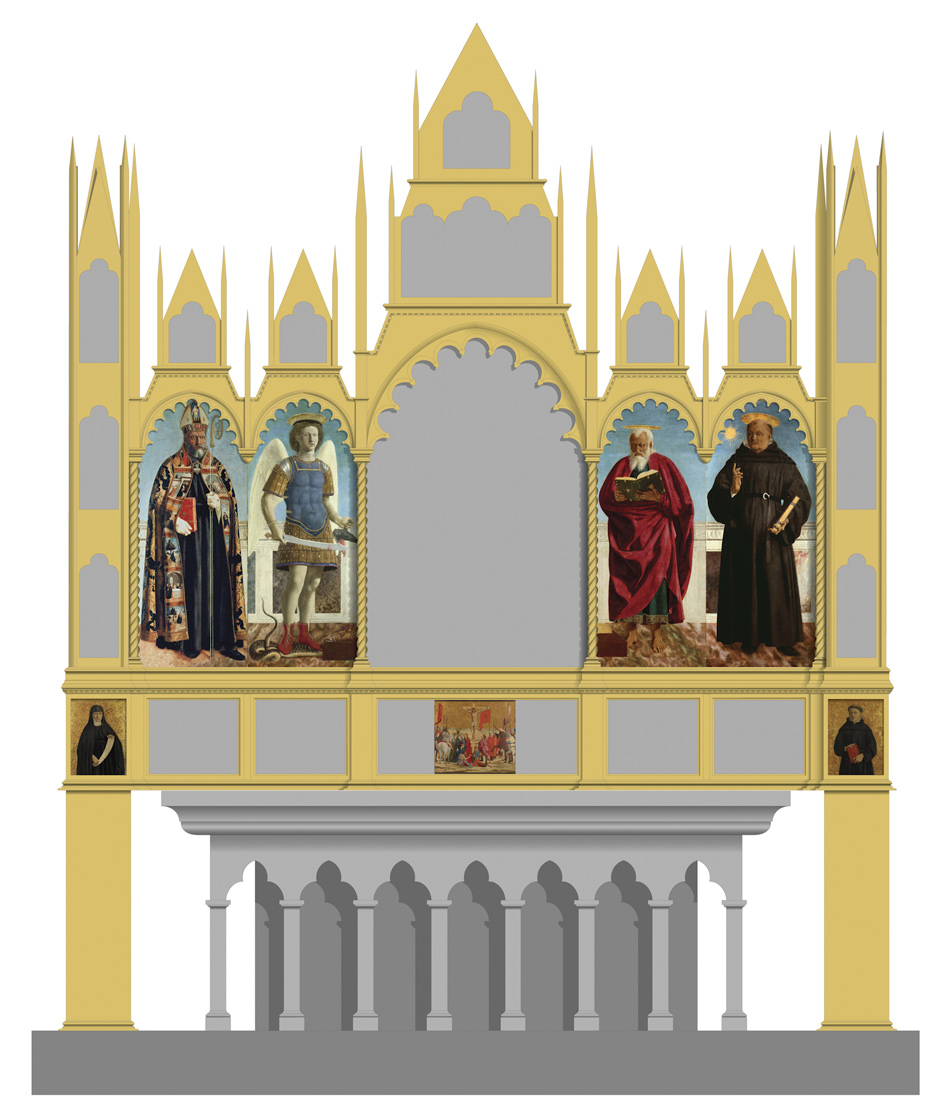
The Frick Collection, New York City
A hypothetical reconstruction of Piero della Francesca’s altarpiece for the church of Sant’Agostino, showing the position of seven of its eight surviving panels. In the top row, from left to right, are Saint Augustine, Saint Michael, Saint John the Evangelist, and Saint Nicholas of Tolentino. In the bottom row are Saint Monica, the Crucifixion, and (possibly) Saint Leonard.
An outstanding feat of historical reconstruction was performed by Millard Meiss in “A Documented Altarpiece by Piero della Francesca,” the magisterial article he published in 1941, in which he describes what the Sant’Agostino altarpiece must have looked like and conjectures correctly the subjects of panels missing at that time.10 By remarkable coincidence, the Florentine art historian Roberto Longhi reached many of the same conclusions and made similar conjectures almost simultaneously; they were published in the second, expanded edition of his Piero della Francesca, completed in 1942 but published only after the war, in 1946. Because of the war, however, neither scholar had any idea until much later of the other scholar’s work or of how completely they were in agreement. Both scholars guessed that the fourth (missing) saint would be Augustine and he was discovered shortly thereafter in Lisbon by Kenneth Clark, who identified him and his artist in an article in the Burlington Magazine in 1947.11 The important central panel has never been found.
The Sant’Agostino polyptych had five main panels depicting, from left to right, Saint Augustine (now in Lisbon and shown at the Frick), Saint Michael (in London), Madonna and Child (missing), Saint John the Evangelist (in the Frick Collection), and Saint Nicholas of Tolentino (in Milan). As in most Renaissance altarpieces, these large panels were surrounded with smaller panels, some of them comprising the predella that formed the base of the altarpiece, others located elsewhere in the overall frame devised for them. The picture that the Frick Collection bought in 1936 for the then-record-breaking sum of $400,000 has been given various identifications, including Saint Andrew and Saint Simon Zelotes, but there is now general agreement that this grave, elderly figure represents Saint John the Evangelist and was the first of the four saints painted by Piero.
Juxtaposed to the youthful Saint Michael on the other side of the central panel, who is poised in the moment of his triumphant action of killing the dragon, this aged, white-haired, sun-darkened Saint John is lost in deep contemplation of the book he is reading. The light falls on his intricately painted, hoary beard, as if to emphasize his extreme age; his elderly hands, exquisitely rendered in reflected light, and his gnarled feet firmly planted on the marble floor underscore his antiquity.
The play of light on the rubies, pearls, and aquamarines that encrust the embroidered gold border on the hem of the saint’s robe is a bravura performance that anticipates similar prodigious renditions of light on jewels in the adjacent Saint Michael and on those worn by angels in some of Piero’s late pictures. (For example, the art historian Judith Field observes about the lines of seed pearls on the top of Saint Michael’s red boots: “As painted, each pearl is about the size of a pinhead, and each one is different, to take account of the different way the light is falling on it.”12) Saint John’s voluminous crimson cloak, absorbing the light into its heavy folds, gives him a massive monumentality, and unlike the other three saints, he is utterly oblivious of the world around him, rapt in thoughtful concentration.
Advertisement
The most splendid picture in the Frick exhibition is the magnificent figure of Saint Augustine from the Museu Nacional de Arte Antiga in Lisbon, a companion to Saint John the Evangelist on the Sant’Agostino altarpiece. (See the illustration on this page.) In several other pictures, in Arezzo, Rimini, and Urbino, Piero painted figures wearing rich brocades, but this Saint Augustine, the patron saint and founding father of the Augustinian order for which the altarpiece was commissioned, wears the most sumptuous garment in all of Piero’s work. His damask cope is of cloth of gold with brocading wefts of dark blue velvet, and it has a golden fringe at the bottom. As a bishop, Saint Augustine wears a pearl-covered mitre, on which is shown the majestic, full-length figure of the risen Christ holding the cross, beneath whom, on the mitre’s band, there are portraits of martyrs; in his left hand the saint holds a beautifully rendered crystal crozier, the crook of which is elegantly foreshortened. On the clasp holding together the two sides of the cope the Resurrection (symbol of Borgo San Sepolcro) is depicted, and on the orphrey, the broad, embroidered band at the cope’s edges, there are ten miniature scenes from the life of Christ, starting with the Annunciation and, in what is visible, going as far as the Crucifixion.
Three scenes, presumably including both a Deposition and an Entombment and possibly a Descent into Limbo, are hidden from view by a fold in the cope. Kenneth Clark, who first identified this panel, felt that these embroidered scenes were the work of an assistant, but both Roberto Longhi and John Pope-Hennessy have persuasively argued that they are by the hand of Piero himself.
Saint Augustine is the most lordly of the four saints depicted on either side of the missing central panel. As portrayed by Piero, he is majestic, resolute, impassive, motionless. Piero is, as I’ve said, famous for the lack of movement in his paintings. This is true even in his chaotic battle scenes at Arezzo, where, as Longhi observes, “his style captures and freezes movement during those momentary pauses which, paradoxically, reveal action at its most intense.”13 And Kenneth Clark speaks of “the immobile warriors who appear in Piero’s somnambulistic battles.”14
Mostly, Piero depicted not action but tranquil, assured immobility, and probably the only genuinely mouvementé figure in all of his work is the man taking off his shirt in the early Baptism (now in London). The grandly sacerdotal Saint Augustine, radiant in his golden cope, solid as a stone pillar in a cathedral, the stillest of the four saints portrayed, embodies a faith as firm and determined as the clenched fist with which he holds his crozier.
The geometrically ordered little Crucifixion in the exhibition, which is also from the Sant’Agostino altarpiece and reminded Berenson of Cézanne,15 is suffused with light and with a glorious panoply of what Longhi termed “light-loving colors.”16 This painting was left to the Frick in his will by John D. Rockefeller Jr. Some forty years ago I was told that, because her father hadn’t bought the painting himself, the redoubtable Helen Clay Frick peevishly refused to hang it with the collection, and so it was lent to Princeton during her lifetime. This has been confirmed by Caroline Elam, who recounted Miss Frick’s anger at Rockefeller, a trustee of the Frick Collection, in a lecture she gave at the Frick in 2004.17
The crucifixion panel, dated by Longhi “around 1460 or later,”18 has been cut down and has suffered a good deal from wear and from restorations done in Italy just before World War I, but even so, it remains a ravishing little picture, with consummate composition and spectacular colors that confirm Leon Battista Alberti’s observation (a statement that could also have been made by Hans Hofmann half a millenium later) that “there is a sort of friendship between colors, so that their grace and beauty are increased when they are placed next to each other.”19 The distant background has been badly damaged, but I’d like to think we can just faintly discern the vestiges of one of those placid streams reflecting the landscape of their banks—le chiare fiumane, D’Annunzio called them—that appear again and again in Piero’s paintings, like some recurrent melody in Schubert. (They appear in his The Death of Adam, The Adoration of the Cross, and The Battle of Constantine and Maxentius in Arezzo, The Baptism and Nativity in London, the Portrait of Federico de Montefeltro and his Triumph in Florence, and the Saint Jerome in Venice.) Although Kenneth Clark thought this Crucifixion was mostly painted by the same assistant who he believed had painted the scenes on Saint Augustine’s cope, most art historians now attribute it to Piero and surmise it was the central panel of the predella of the Sant’Agostino altarpiece, located directly under the missing central panel of the Madonna and Child.
The Virgin and Child Enthroned with Four Angels from the Clark Art Institute in Williamstown, Massachusetts, is not from the Sant’Agostino altarpiece. (See the illustration on page 9.) Although an Italian art historian has suggested that this picture might have been the missing central panel of that altarpiece, this is patently impossible, not simply because its size is wrong, but also because the base of the throne does not extend out of the picture, as the throne in the central panel must. Where the Clark Art Institute picture should be located in Piero’s oeuvre is much debated, and when it was last exhibited in New York, at the Metropolitan Museum in 2005, the six scholars who wrote about it in the catalog were unable to agree on a date for it.20
The four angels and the Madonna each display the direct, unmediated gaze we associate with Fayum portraits, and, as Philip Hendy observed, “this Madonna comes almost straight from the farm.”21 Looking at this serene picture, one is reminded of D’Annunzio’s astute perception about Piero: “E un Greco ritmo corse il pio silenzio” (“And a Greek rhythm wafts across the holy silence”).22 The strong light coming from the left makes radiant the exquisite range of pale colors and gives the picture an airy luminance that helps compensate for its somewhat claustrophobically crowded composition. On the right, an angel pointing to the divine child looks directly at the viewer, as if in compliance with Alberti’s wish to have such a figure in “historical paintings”:
Then, I like there to be someone in the “historia” who tells the spectators what is going on, and either beckons them with his hand to look…or points to some danger or remarkable thing in the picture, or by his gestures invites you to laugh or weep with them.23
The play of light and shadow upon the rosettes on the front of the upper step of the Madonna’s throne is nothing less than miraculous, and, as always, there is something genial and tender about Piero’s depiction of the angels’ feet—what T.S. Eliot called Piero’s “unoffending feet” (“Mr. Eliot’s Sunday Morning Service”). The elaborate architecture of the atrium in which these figures are situated has, understandably, been much commented upon by scholars, as has the clever placing of the off-center Corinthian capital next to the caput of the Virgin. This is the most hieratic of all Piero’s pictures. And, in Zbigniew Herbert’s words, “once more geometry has absorbed passion.”24
In significant ways, Piero’s paintings are the quintessential artistic expression of the quattrocento humanism given definition by authors like Leonardo Bruni, Poggio Bracciolini, Poliziano, Vittorino da Feltre, and Pico della Mirandola—much as the Pazzi Chapel in Florence is the architectural expression of those same Renaissance ideals. Describing an orderly, rational world of individual freedom and dignity inspired by the world of classical antiquity, they extol the virtues of eloquence and learning, liberty and aspiration, personal nobility, goodness, and beauty. With inherent hopeful optimism, they depict an ideal universe of the imagination in which man, endowed with unlimited capacities and encompassing intelligence, has the possibility of perfecting himself and creating a harmonious society of virtuous citizens. That ideal world is one of the noblest dreams of Western man, and it suffuses the paintings of Piero della Francesca; for they depict, as Berenson wrote, “his dream of surroundings worthy of his mind and heart, where his soul would feel at home.”25
This Issue
March 21, 2013
When the Jihad Came to Mali
Homunculism
-
1
John Addington Symonds, Renaissance in Italy: The Fine Arts (1877; John Murray, 1927), p. 170. ↩
-
2
See, for example, Donata Levi, quoted by Caroline Elam in Roger Fry and the Re-Evaluation of Piero della Francesca (Council of The Frick Collection, 2004), p. 56, note 64: “Straordinario come la luce luminosa in pieno giorno gira da per tutto la scena…. Non ha cercato di chiudere la luce ma l’ha fatto girare in tutte le parti. Questo è modo tutto suo e da lui creato….” ↩
-
3
Bernard Berenson, Piero della Francesca, or The Ineloquent in Art (Macmillan, 1954), p. 3. ↩
-
4
Zbigniew Herbert, The Collected Prose, 1948–1998 (Ecco, 2010), p. 154. ↩
-
5
Herbert, The Collected Prose, pp. 154–155. ↩
-
6
Millard Meiss, “A Documented Altarpiece by Piero della Francesca,” The Art Bulletin, Vol. 23 (March 1941), pp. 53–68; reprinted posthumously with alterations and additions in Millard Meiss, The Painter’s Choice: Problems in the Interpretation of Renaissance Art (Harper and Row, 1976), pp. 82–104, quote on p. 83. ↩
-
7
For Angelo, his brother, and his sister-in-law, see the essay “Piero della Francesca: The Commission and Completion of the Sant’Agostino Altarpiece” by James Banker, who knows more than anyone about the world of Borgo San Sepolcro in Piero’s day, in the Frick catalog, Piero della Francesca in America, pp. 73–74. ↩
-
8
Meiss, The Painter’s Choice, pp. 83, 87, 98; Philip Hendy, Piero della Francesca and the Early Renaissance (Macmillan, 1968), pp. 120–121. ↩
-
9
See Piero della Francesca in America, p. 11, and pp. 38, 54, and 94, and see also Franco Polcri, Due ritrovamenti d’archivio a Sansepolcro (Sansepolcro, February 17, 1990). ↩
-
10
See Meiss, The Painter’s Choice. ↩
-
11
Kenneth Clark, “Piero della Francesca’s St. Augustine Altarpiece,” Burlington Magazine, Vol. 89 (1947), pp. 205–209, reprinted in The Burlington Magazine: A Centenary Anthology, edited by Michael Levey (Yale University Press, 2003), pp. 81–86. ↩
-
12
J.V. Field, Piero della Francesca: A Mathematician’s Art (Yale University Press, 2005), p. 191. ↩
-
13
Roberto Longhi, Piero della Francesca, translated by David Tabbat (Stanley Moss–Sheep Meadow Book, 2002), pp. 167–168. ↩
-
14
Kenneth Clark in The Burlington Magazine: A Centenary Anthology, p. 85. ↩
-
15
Letter to Duveen, November 18, 1915; quoted in Silvia Sprigge, Berenson: A Biography (Houghton Mifflin, 1960), pp. 206–207. ↩
-
16
Longhi, Piero della Francesca, p. 161. ↩
-
17
Elam, Roger Fry and the Re-Evaluation of Piero della Francesca, p. 9. ↩
-
18
Longhi, Piero della Francesca, p. 132. ↩
-
19
“Atqui est quidem nonnulla inter colores amicitia ut iuncti alter alteri gratiam et venustatem augeat,” Leon Battista Alberti, On Painting and On Sculpture, edited by Cecil Grayson (Phaidon, 1972), p. 92 (my translation). Hubert Damisch calls the De Pictura (1435) “one of the founding texts of Western culture” in A Childhood Memory by Piero della Francesca (Stanford University Press, 2007), p. 10. ↩
-
20
From Filippo Lippi to Piero della Francesca: Fra Carnevale and the Making of a Renaissance Master, edited by Keith Christiansen (Metropolitan Museum, 2005), pp. 271–277. ↩
-
21
Hendy, Piero della Francesca and the Early Renaissance, p. 61. ↩
-
22
This is from the third of the Arezzo Città del Silenzio sonnets in Elettra (1903). See Gabriele d’Annunzio, Versi d’Amore e di Gloria (Mondadori, 1982), p. 393. Roger Fry, in a letter to his father about Piero, observed in 1897: “He certainly comes nearer to the Greeks than any other Italian.” Cited in Elam, Roger Fry and the Re-Evaluation of Piero della Francesca, p. 22. ↩
-
23
“Tum placet in historia adesse quempiam qui earum quae gerantur rerum spectatores admoneat, aut manu ad visendum advocet…aut periculum remve aliquam illic admirandum demonstret, aut ut una adrideas aut ut simul deplores suis te gestigus invitet,” in Alberti, On Painting and On Sculpture, pp. 80 and 83. ↩
-
24
Herbert, The Collected Prose, p. 147. ↩
-
25
Berenson, Piero della Francesca, or the Ineloquent in Art, p. 5. ↩


